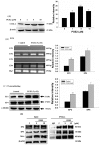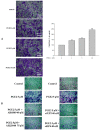Prostaglandin E2-Induced COX-2 Expressions via EP2 and EP4 Signaling Pathways in Human LoVo Colon Cancer Cells
- PMID: 28587064
- PMCID: PMC5485956
- DOI: 10.3390/ijms18061132
Prostaglandin E2-Induced COX-2 Expressions via EP2 and EP4 Signaling Pathways in Human LoVo Colon Cancer Cells
Abstract
Metastasis is the most dangerous risk faced by patients with hereditary non-polyposis colon cancer (HNPCC). The expression of matrix metalloproteinases (MMPs) has been observed in several types of human cancers and regulates the efficacy of many therapies. Here, we show that treatment with various concentrations of prostaglandin E2 (PGE2; 0, 1, 5 or 10 μM) promotes the migration ability of the human LoVo colon cancer cell line. As demonstrated by mRNA and protein expression analyses, EP2 and EP4 are the major PGE2 receptors expressed on the LoVo cell membrane. The Phosphatidylinositol-4,5-bisphosphate 3-kinase (PI3K)/Akt cell survival pathway was upregulated by EP2 and EP4 activation. Following the activation of the PI3K/Akt pathway, β-catenin translocated into the nucleus and triggered COX2 transcription via LEF-1 and TCF-4 and its subsequent translation. COX2 expression correlated with the elevation in the migration ability of LoVo cells. The experimental evidence shows a possible mechanism by which PGE2 induces cancer cell migration and further suggests PGE2 to be a potential therapeutic target in colon cancer metastasis. On inhibition of PGE2, in order to determine the downstream pathway, the levels of PI3K/Akt pathway were suppressed and the β-catenin expression was also modulated. Inhibition of EP2 and EP4 shows that PGE2 induces protein expression of COX-2 through EP2 and EP4 receptors in LoVo colon cancer cells.
Keywords: COX-2; EP2 and EP4 receptors; hereditary non-polyposis colon cancer (HNPCC); prostaglandin E2 (PGE2); β-catenin.
Conflict of interest statement
The authors declare no conflict of interest.
Figures









Similar articles
-
Upregulation of the S1P3 receptor in metastatic breast cancer cells increases migration and invasion by induction of PGE2 and EP2/EP4 activation.Biochim Biophys Acta. 2016 Nov;1861(11):1840-1851. doi: 10.1016/j.bbalip.2016.09.005. Epub 2016 Sep 9. Biochim Biophys Acta. 2016. PMID: 27616330
-
Thymoquinone suppresses migration of LoVo human colon cancer cells by reducing prostaglandin E2 induced COX-2 activation.World J Gastroenterol. 2017 Feb 21;23(7):1171-1179. doi: 10.3748/wjg.v23.i7.1171. World J Gastroenterol. 2017. PMID: 28275297 Free PMC article.
-
Activation of prostaglandin EP4 receptor attenuates the induction of cyclooxygenase-2 expression by EP2 receptor activation in human amnion fibroblasts: implications for parturition.FASEB J. 2019 Jul;33(7):8148-8160. doi: 10.1096/fj.201802642R. Epub 2019 Mar 27. FASEB J. 2019. PMID: 30917001
-
EP4 receptor as a novel promising therapeutic target in colon cancer.Pathol Res Pract. 2020 Dec;216(12):153247. doi: 10.1016/j.prp.2020.153247. Epub 2020 Oct 19. Pathol Res Pract. 2020. PMID: 33190014 Review.
-
Prostaglandin E2 in the Tumor Microenvironment, a Convoluted Affair Mediated by EP Receptors 2 and 4.Pharmacol Rev. 2024 May 2;76(3):388-413. doi: 10.1124/pharmrev.123.000901. Pharmacol Rev. 2024. PMID: 38697857 Review.
Cited by
-
Prostaglandin Pathways: Opportunities for Cancer Prevention and Therapy.Cancer Res. 2022 Mar 15;82(6):949-965. doi: 10.1158/0008-5472.CAN-21-2297. Cancer Res. 2022. PMID: 34949672 Free PMC article. Review.
-
The COX-2/PGE2 Response Pathway Upregulates Radioresistance in A549 Human Lung Cancer Cells through Radiation-Induced Bystander Signaling.Biology (Basel). 2023 Oct 25;12(11):1368. doi: 10.3390/biology12111368. Biology (Basel). 2023. PMID: 37997966 Free PMC article.
-
Evaluation of Microglia/Macrophage Cells from Rat Striatum and Prefrontal Cortex Reveals Differential Expression of Inflammatory-Related mRNA after Methamphetamine.Brain Sci. 2019 Nov 25;9(12):340. doi: 10.3390/brainsci9120340. Brain Sci. 2019. PMID: 31775383 Free PMC article.
-
EP2 Antagonists (2011-2021): A Decade's Journey from Discovery to Therapeutics.J Med Chem. 2021 Aug 26;64(16):11816-11836. doi: 10.1021/acs.jmedchem.1c00816. Epub 2021 Aug 5. J Med Chem. 2021. PMID: 34352171 Free PMC article. Review.
-
Prostaglandin and prostaglandin receptors: present and future promising therapeutic targets for pulmonary arterial hypertension.Respir Res. 2023 Nov 1;24(1):263. doi: 10.1186/s12931-023-02559-3. Respir Res. 2023. PMID: 37915044 Free PMC article. Review.
References
MeSH terms
Substances
LinkOut - more resources
Full Text Sources
Other Literature Sources
Research Materials

